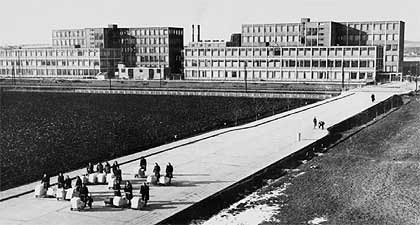Production and Work at Bata Co.

In the visions of the modern architects of the 20th century, industry was the only reason to create a town. Batovany represented such a town. It was created "from scratch" as a machine for working and living in, to paraphrase Le Corbusier, the guru of the Modern Movement. Production was the triggering and propulsion mechanism of all the Bata Co. satellite towns. The rhythm of production in the towns also determined the rhythm of living. The town's further development or even existence depended on the prosperity of production. The production plant in Batovany was also the alpha and omega of every inhabitant's life. They all in some way participated in production, by working directly with machines or by operating in construction or services. This dependency lessened first in the late 1950s, when other types of production or employment opportunities were created in the town. The Bata phenomenon was renowned not only due to its characteristic architecture, but also so-called "Bataism", including the perfectly organized and efficient production and sales. This system involved, for example, the introduction of decentralized workshops (operating as autonomous business units), profit sharing (a variable wage portion motivating higher employee performance), planning (long-term and daily plans were created for production, labour, sales, development, etc.), the company's own chain of stores (in 1931, there were 2500 stores worldwide under the Bata Service), its low-price sales strategy and strategic price-setting (since 1922, all Bata prices ended with the "9" digit) and aggressive advertising as an inevitable tool of the system's success (in accordance with the principle "Our customer is our master!").
As a result of this business strategy, Bata employees had a strong feeling of social security and identification with the company, and they were proud of it. This was obvious, even despite (or due to) the fact that "during the 7-year-long rule of Jan Bata, labour exploitation became extremely sophisticated", as stated by Vladimír Karfík, former head of the construction office in Zlín, and someone familiar with the company's operations. Bata opposed trade unions and the communist ideology. As he saw it, social issues were far rmoved from the leftist ideas of the avant-garde. By introducing social benefits, for example, a five-day working week, he pursued a sophisticated and well-calculated business model. Bata Co. was typical for its uncompromising operations. A perfect performance and absolute devotion to the company were required. The company maintained these above-standard employee relations through different benefits, including high wages, loans, company housing, and education.
» PDF (4,8Mb)
|
Production and Work in Bat'ovany - Partizánske
Shoe production was launched in Batovany in July 1939. The first machinery and employees came to Batovany from Zlín. Despite the fact that Bata created the shoe factory (in the present-day town of Partizánske) on the brink of World War II, it prospered remarkably. Karfík commented on the miraculous war business of Bata: "Everyone's life had changed... Only Bata Co. was perfectly navigating through this new situation and experienced a new growth, mostly because of their military supplies for the Wehrmacht. The mystery is that he profited from the war boom from both fighting superpowers. The strangest fact was that it happened under a bilateral blessing."
On January 1st 1949 the Bata plant was nationalized. Shoe production, however, continued. The well-operating production facility had a long-lasting inertia. Its decline was triggered by decreasing labour productivity that accompanied growing political pressure in the 1970s. The process of decline was paradoxically brought to a head by the political changes in November 1989, together with the plant's subsequent privatization and collapsing markets in Eastern Europe. Today, the facility of the former Bata plant houses several companies involved in shoe production as well as other different activities, including, for example, warehousing.
» PDF (4,2Mb)
|
Multi-level Production Halls

Multi-level production halls rank among the oldest products of Zlín's planning studio. A standardized design for the hall, with a vertical communication core on a central facade, originated probably in 1924. It belongs to the oldest types of production halls built later in the Bata satellite towns The hall's construction base consists of a ferro-concrete monolithic skeleton with a span of 6.15 x 6.16 metres, a round column profile and brick infill. The size of a standard hall was 13 width sections by 13 length sections.
The first three-storey production halls were built in 1938-939. During the next two years, two five-storey production halls were added (1939-1941) including a central staircase and boiler room. They were followed by other five-storey halls (1942-1946) with side staircases.
A conveyer belt was the basis of operations in Bata plants. Portions of manual work were gradually substituted by automation. Despite this fact, daylight illumination and direct ventilation played a significant role in all production processes in the halls. Large areas of glazing in the facades of all the buildings conformed to this approach.
Within the plant, the halls were set out in a chessboard fashion, and interconnected by transportation facilities. The halls were built and opened gradually to lower investment costs.
Even today Bata's production halls in Batovany - Partizánske are used for production or as warehouses. Several of them have been modified, while others have been preserved in their original state as, for example, with the very first three-storey hall.
» PDF (5,2Mb)
English language consultant: Gekko Design.
|
|

|
|
